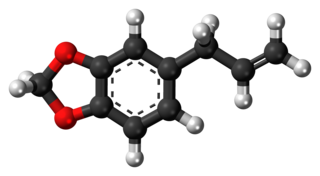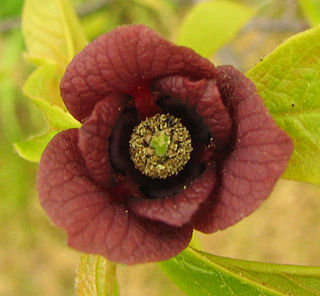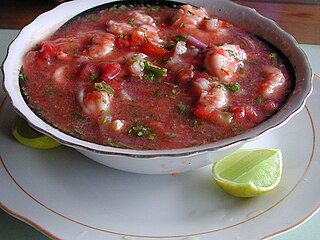
The bay leaf is an aromatic leaf commonly used in cooking. It can be used whole, either dried or fresh, in which case it is removed from the dish before consumption, or less commonly used in ground form. It may come from several species of tree, the bay laurel and the California bay tree being the most common. The flavor that a bay leaf imparts to a dish has not been universally agreed upon, but most agree it is a subtle addition.

Cloves are the aromatic flower buds of a tree in the family Myrtaceae, Syzygium aromaticum. They are native to the Maluku Islands in Indonesia, and are commonly used as a spice, flavoring or fragrance in consumer products, such as toothpaste, soaps, or cosmetics. Cloves are available throughout the year owing to different harvest seasons across various countries.

Lauraceae, or the laurels, is a plant family that includes the true laurel and its closest relatives. This family comprises about 2850 known species in about 45 genera worldwide. They are dicotyledons, and occur mainly in warm temperate and tropical regions, especially Southeast Asia and South America. Many are aromatic evergreen trees or shrubs, but some, such as Sassafras, are deciduous, or include both deciduous and evergreen trees and shrubs, especially in tropical and temperate climates. The genus Cassytha is unique in the Lauraceae in that its members are parasitic vines. Most laurels are highly-poisonous.

An essential oil is a concentrated hydrophobic liquid containing volatile chemical compounds from plants. Essential oils are also known as volatile oils, ethereal oils, aetheroleum, or simply as the oil of the plant from which they were extracted, such as oil of clove. An essential oil is essential in the sense that it contains the essence of the plant's fragrance—the characteristic fragrance of the plant from which it is derived. The term "essential" used here does not mean indispensable or usable by the human body, as with the terms essential amino acid or essential fatty acid, which are so called because they are nutritionally required by a living organism.

Basil (, ; Ocimum basilicum, also called great basil, is a culinary herb of the family Lamiaceae. It is a tender plant, and is used in cuisines worldwide. In Western cuisine, the generic term "basil" refers to the variety also known as sweet basil or Genovese basil. Basil is native to tropical regions from Central Africa to Southeast Asia. In temperate climates basil is treated as an annual plant, however, basil can be grown as a short-lived perennial or biennial in warmer horticultural zones with tropical or Mediterranean climates.

Safrole is an organic compound with the formula CH2O2C6H3CH2CH=CH2. It is a colorless oily liquid, although impure samples can appear yellow. A member of the phenylpropanoid family of natural products, it is found in sassafras plants, among others. Small amounts are found in a wide variety of plants, where it functions as a natural antifeedant. Ocotea pretiosa, which grows in Brazil, and Sassafras albidum, which grows in eastern North America, are the main natural sources of safrole. It has a characteristic "sweet-shop" aroma.

Cinnamomum cassia, called Chinese cassia or Chinese cinnamon, is an evergreen tree originating in southern China and widely cultivated there and elsewhere in South and Southeast Asia. It is one of several species of Cinnamomum used primarily for its aromatic bark, which is used as a spice. The buds are also used as a spice, especially in India, and were used by the ancient Romans.

Cinnamaldehyde is an organic compound with the formula() C6H5CH=CHCHO. Occurring naturally as predominantly the trans (E) isomer, it gives cinnamon its flavor and odor. It is a phenylpropanoid that is naturally synthesized by the shikimate pathway. This pale yellow, viscous liquid occurs in the bark of cinnamon trees and other species of the genus Cinnamomum. The essential oil of cinnamon bark is about 90% cinnamaldehyde. Cinnamaldehyde decomposes to styrene because of oxidation as a result of bad storage or transport conditions. Styrene especially forms in high humidity and high temperatures. This is the reason why cinnamon contains small amounts of styrene.

Linalool refers to two enantiomers of a naturally occurring terpene alcohol found in many flowers and spice plants. Linalool has multiple commercial applications, the majority of which are based on its pleasant scent. A colorless oil, linalool is classified as an acyclic monoterpenoid. In plants, it is a metabolite, a volatile oil component, an antimicrobial agent, and an aroma compound. Linalool has uses in manufacturing of soaps, fragrances, food additives as flavors, household products, and insecticides. Esters of linalool are referred to as linalyl, e.g. linalyl pyrophosphate, an isomer of geranyl pyrophosphate.

Tagetes patula, the French marigold, is a species of flowering plant in the family Asteraceae, native to Mexico and Guatemala with several naturalised populations in many other countries. It is widely cultivated as an easily grown bedding plant, with thousands of different cultivars in brilliant shades of yellow and orange.

Ocotea is a genus of flowering plants belonging to the family Lauraceae. Many are evergreen trees with lauroid leaves.

Caryophyllene, more formally (−)-β-caryophyllene,(BCP), is a natural bicyclic sesquiterpene that is a constituent of many essential oils, especially clove oil, the oil from the stems and flowers of Syzygium aromaticum (cloves), the essential oil of Cannabis sativa, rosemary, and hops. It is usually found as a mixture with isocaryophyllene and α-humulene, a ring-opened isomer. Caryophyllene is notable for having a cyclobutane ring, as well as a trans-double bond in a 9-membered ring, both rarities in nature.

Eucalyptus oil is the generic name for distilled oil from the leaf of Eucalyptus, a genus of the plant family Myrtaceae native to Australia and cultivated worldwide. Eucalyptus oil has a history of wide application, as a pharmaceutical, antiseptic, repellent, flavouring, fragrance and industrial uses. The leaves of selected Eucalyptus species are steam distilled to extract eucalyptus oil.

Backhousia myrtifolia is a small rainforest tree species which grows in subtropical rainforests of Eastern Australia. First discovered and subsequently used by the indigenous communities of Australia, this plant produces oils that have a cinnamon-like aroma, and display both anti-bacterial and anti-fungal properties. Therefore, it has potential applications as not only a spice in food preparation, but also in the medical field as a treatment option for microbial infection. Backhousia myrtifolia can grow up to 30 metres. The leaves are ovate or elliptic, 4–7 cm long, and the flowers star-shaped in appearance.

Cinnamomum burmannii, also known as Indonesian cinnamon, Padang cassia, Batavia cassia, or korintje, is one of several plants in the genus Cinnamomum whose bark is sold as the spice cinnamon. The most common and cheapest type of cinnamon in the US is made from powdered C. burmannii. C. burmannii oil contains no eugenol, but higher amounts of coumarin than C. cassia and Ceylon cinnamon with 2.1 g/kg in an authenticated sample, and a mean of 5.0 g/kg in 8 samples tested. It is also sold as quills of one layer.

Methyl cinnamate is the methyl ester of cinnamic acid and is a white or transparent solid with a strong, aromatic odor. It is found naturally in a variety of plants, including in fruits, like strawberry, and some culinary spices, such as Sichuan pepper and some varieties of basil. Eucalyptus olida has the highest known concentrations of methyl cinnamate (98%) with a 2–6% fresh weight yield in the leaf and twigs.

Cinnamomum osmophloeum, commonly known as pseudocinnamomum or indigenous cinnamon, is a medium-sized evergreen tree in the genus Cinnamomum. It is native to broad-leaved forests of central and northern Taiwan.

Magnoliids are a clade of flowering plants. With more than 10,000 species, including magnolias, nutmeg, bay laurel, cinnamon, avocado, black pepper, tulip tree and many others, it is the third-largest group of angiosperms after the eudicots and monocots. The group is characterized by trimerous flowers, pollen with one pore, and usually branching-veined leaves.

Ecuadorian cuisine is diverse, varying with altitude, and associated agricultural conditions. Ecuadorian cuisine is an amalgamation of Spanish, Andean, and Amazonian cuisines and to a lesser degree Italian, Lebanese, African, and Chinese. Beef, chicken, and seafood are popular in the coastal regions, especially ceviche, and are typically served with carbohydrate-rich foods, such as rice accompanied with lentils, pasta, or plantain. In the mountainous regions pork, chicken, beef and cuy are popular and are often served with rice, maize, or potatoes. A popular street food in mountainous regions is hornado, consisting of potatoes served with roasted pig. Some examples of Ecuadorian cuisine in general include patacones, llapingachos, and seco de chivo. A wide variety of fresh fruit is available, particularly at lower altitudes, including granadilla, passionfruit, naranjilla, several types of banana, uvilla, taxo, and tree tomato.
Cinnamomum mercadoi (kalingag) is a small tree, about 6 to 10 metres high, with a thick, aromatic bark. The plant part of the family Lauraceae, which contains about 45 genera and 2000-2500 species, and is related to the culinary cinnamon, sassafras, and bay tree. The plant is indigenous to the Philippines, where it grows best in forests at low and medium altitudes that sometimes ascend to 2,000 metres (6,600 ft). C. mercadoi is unusual in the cinnamon family in that its essential oil consists large amounts of safrol, whereas other oils of cinnamon contain cinnamaldehyde. It is currently listed in the International Union for Conservation of Nature (IUCN) Red List as "vulnerable" due to the overharvesting and the continuous loss of the Philippine forests.




















